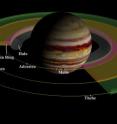Scientists find rings of Jupiter are shaped in shadow
Scientists from the University of Maryland and the Max-Planck Institute for Solar System Research in Germany appear to have solved a long-standing mystery about the cause of anomalies in Jupiter's gossamer rings. In a new study published in the May 1 issue of Nature, they report that a faint extension of the outermost ring beyond the orbit of Jupiter's moon Thebe, and other observed deviations from an accepted model of ring formation, result from the interplay of shadow and sunlight on dust particles that make up the rings.
" It turns out that the outer ring's extended boundary and other oddities in Jupiter's rings really are 'made in the shade,'" said Douglas Hamilton, a professor of astronomy at the University of Maryland. " As they orbit about the planet, dust grains in the rings alternately discharge and charge when they pass through the planet's shadow. These systematic variations in dust particle electric charges interact with the planet's powerful magnetic field. As a result small dust particles are pushed beyond the expected ring outer boundary, and very small grains even change their inclination, or orbital orientation, to the planet."
Hamilton and German co-author Harald Krüger studied for the first time new impact data on dust grain sizes, speeds, and orbital orientations taken by the spacecraft Galileo during its traversal of Jupiter's rings in 2002-2003, as part of its deliberate maneuvering for a death plunge into the planet. Krüger analyzed the new data set and Hamilton created elaborate computer models that matched dust and imaging data on Jupiter's rings and explained the observed eccentricities.
" Within our model we can explain all essential structures of the dust ring we observed, " said Krüger.
According to Hamilton, the mechanisms identified in this paper effect the rings of any planet in any solar system, but the effects may not be as evident as it is at Jupiter. " The icy particles in Saturn's famous rings are too large and heavy to be significantly shaped by this process, which is why similar anomalies are not seen there," he said. " Our findings on the effects of shadow may also shed some light on aspects of planetary formation because electrically charged dust particles must somehow combine into larger bodies from which planets and moons are ultimately formed. "
Source: University of Maryland
Other sources
- Jupiter's Rings Made in the Shadefrom Space.comMon, 5 May 2008, 11:07:03 UTC
- Jupiter's Shadowy Ring Behaviorfrom Science NOWWed, 30 Apr 2008, 21:35:03 UTC
- Scientists Find Rings of Jupiter Are Shaped in Shadowfrom Newswise - ScinewsWed, 30 Apr 2008, 20:35:06 UTC
- Jupiter's Rings Are Shaped By Interplay Of Sunlight And Shadowfrom Science DailyWed, 30 Apr 2008, 20:14:02 UTC
- Scientists find rings of Jupiter are shaped in shadowfrom PhysorgWed, 30 Apr 2008, 18:53:01 UTC
